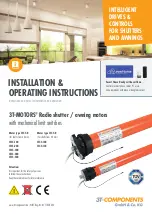
7
INSTALLATION AND MAINTENANCE
CPLS drip-proof 3-phase induction motors
4240 en - 2014.09 / b
LEROY-SOMER
Balancing
Rotating machines are balanced in accordance with standard
ISO 8821:
- Half-key when the shaft extension is marked H: standard
- No key when the shaft extension is marked N
- Full key when the shaft extension is marked F, thus any
coupling element (pulley, coupling sleeve, slip-ring, etc) must
be balanced accordingly.
Motor with 2 shaft extensions:
If the second shaft extension is not used, in order to comply
with the balancing class, the key or half-key must be fixed
firmly in the keyway so that it is not thrown out during rotation
(H or F balancing) and must be protected against direct contact.
Precautions
All measures must be taken to ensure protection against the
risks which arise when there are rotating parts (coupling
sleeve, pulley, belt, etc).
Beware of backdriving when the motor is
switched off. The appropriate precautions must
be taken:
- On pumps: install a non-return valve
- On mechanical devices, install a backstop or a holding
brake, etc.
Tolerances and adjustments
The standard tolerances are applicable to the mechanical
characteristics given in our catalogues. They comply fully with
the requirements of standard EN 60072-1.
When fitting the coupling:
- Users must adhere strictly to the instructions provided by the
transmission device supplier.
- Avoid impacts which could damage the bearings.
To do this, use a spanner and grease the tapped hole of the
shaft extension with a special lubricant (e.g. molykote grease)
to make it easier to fit the coupling.
The hub of the transmission device must be:
- Fully in contact with the shoulder of the shaft.
- Longer than the shaft extension (2 to 3 mm) so that it can be
tightened using a screw and washer. If it is not, a spacer ring
must be inserted without cutting the key (if this ring is large, it
must be balanced).
If there is a second shaft extension, it must only be used for
direct coupling and the same recommendations must be
followed.
Inertia flywheels must not be mounted directly onto the shaft
extension, but installed between end shields and connected by
a coupling sleeve.
End shields fitted with flanges are designed to ensure good-
quality positioning, but cannot support the weight of excessively
heavy equipment.
To access the flange drill holes on the CPLS 250,
the DE shield ventilation grilles need to be
removed.
Make sure that the winding power is off during this
operation.
Take all the necessary precautions to avoid damaging
the winding while mounting the driven equipment.
Direct connection onto the machine
When mounted directly on the motor shaft extension of the
moving device (pump or fan turbine), check that this device is
perfectly balanced and that the radial force and the axial thrust
are within the limits indicated in the CPLS catalogue for
maintaining the bearings.
Direct connection using a flexible coupling
Selection of the coupling sleeve should take account of the
rated torque to be transmitted and the safety factor dependent
on the starting conditions for the electric motor.
The machines must be carefully aligned, so that any lack of
concentricity and parallelism in the two coupling halves is
compatible with the recommendations of the coupling sleeve
manufacturer.
Both coupling halves should be provisionally assembled to
assist moving them in relation to one another.
Adjust the parallel plane of both shafts using a gauge. Measure
the distance between the two coupling surfaces at one point on
the circumference. Rotate them 90°, 180° and 270° in relation
to this initial position, and measure each time. The difference
between the two extreme values of dimension “x” must not
exceed 0.05 mm for standard couplings.
To perfect this adjustment and at the same time check the
concentricity of the two shafts, fit 2 gauges as shown in the
diagram and slowly turn both shafts.
Summary of Contents for CPLS 112
Page 27: ......








































